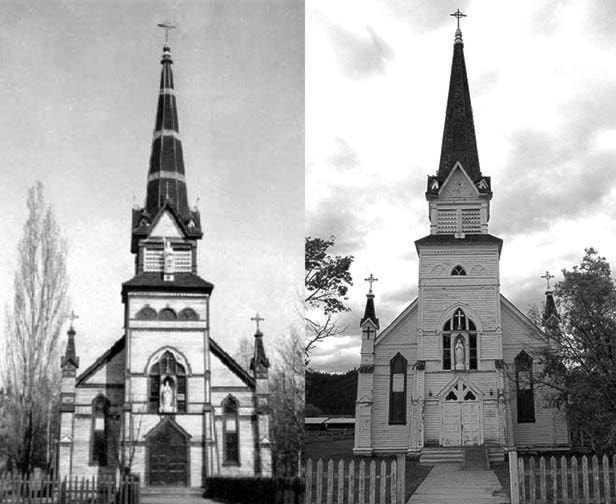Jim Cameron
"Indian Pierre, the same one who was to chase me out of the Kootenays or kill me was waiting for my return. Coming to the house he threw a lump of mineral the size of a goose egg. Seeing him silent and nervous I picked it up, looked at it and said: 'What is that?' not knowing much about minerals at that time. He answered: 'You always say Indians good for nothing. We shall see what you are good for yourself.'
"To show Pierre that I was taking an interest in it, I kept on questioning: 'Did you find it on the hillside or on the flat?' 'Come and see,' was the answer. 'Was it on a slide among other rocks or detached from the hill side?' 'Come and see,' was the answer."
And so it was that a chance discovery led to the creation of the St. Eugene Mine at Moyie. So too, did it lead to the construction of the St. Eugene Mission Church in 1897, one of the loveliest of its type in Western Canada, not to mention its slightly less grand sister-church of St. Peter's built in 1904 in the town of Moyie.
But let us back up a tad. Indian Pierre didn't happen upon the ore sample entirely by chance. He was looking for just such stones at the behest of Father Coccola; a great many people were looking for shiny stones.
As to the matter of Pierre (Pielle or Peter in other versions, but we'll stick with Father Coccola's version since he was there at the time) wanting to chase the Father out of the Kootenays or kill him, Father Coccola refers to a previous altercation in which he was approached by a generally resentful if not downright cranky Pierre and ordered to leave the country on pain of death. Father Coccola coolly replied: "I have not come for money or a good time but to help the Indians to live well and show them the way to heaven and as long as there is any Indian living or myself living I shall not leave the country."
"Then we will kill you," Pierre threatened. Father Coccola, becoming vexed, responded, "Go ahead, it is better to die than live with men like you. I have been so far taking care of your bodies and souls and you, worse than dogs, do not appreciate it; I give a bone to a dog and he licks my hand ... Should all the Indians come to kill me I shall not make a step back."
Pierre returned to the people outside, saying (somewhat oddly upon reflection) "That priest is an old soldier, faced many guns and can handle a gun better than any one of us. The Whites love him, the Indians fear him and God takes his word, better to leave him alone."
Poof! There you go. Problem fixed.
And now again to the stone the size of a goose egg: Father Coccola, deciding an arduous trip to the site of the discovery might not be worth the effort, set the rock aside. As circumstance would have it a gentlemen well-versed in mining happened by some days later on his way to the North Star Mine in Kimberley. He stopped by Father Coccola's for lunch, as travellers were wont to do, spotted the stone and offered to have it assayed. When Father Coccola received a letter a short time later asking if the property was for sale he realized that the ore was of some value and rode immediately to Fort Steele to obtain a mining license. There he encountered miner James Cronin of Spokane whom he had previously met in Nelson and in whom he now placed his trust.
The following day the two men, guided by Pierre, left as surreptitiously as possible (claim jumpers being as thick as the thieves they were and in the general habit of keeping a close eye on the licensing office) and hastened on horseback to a site overlooking Moyie Lake. They soon discovered a well-defined vein of rich ore and immediately located five claims which they duly recorded the next day.
The rewards were plentiful. The St. Eugene Mine eventually produced an estimated $10 million of silver-lead ore from 1888-1911. Father Coccola sold his shares for a reported $12,000 in 1888, just as the mine was moving into production and then sank his profits into the Mission, the most notable result being the beautiful Victorian-Gothic St. Eugene Catholic Church that stills stands today.
Rumours abound as to the reward for Pierre but according to Father Coccola he received cattle, farm implements, a model (as in nice) house and $5.00 a month for life from the Consolidated Mining Co. (later Cominco) operators of the St. Eugene and Kimberley Mines.
Father Coccola's final words on the subject: "The object I had in view by a prompt selling of the mine was realized: the development of the district. Railroads and sawmills first, and towns after, put on the map this portion of British Columbia."
Father Coccola may have been gilding the lily somewhat but it is safe to say that the discovery of the mine certainly did a great deal for both the St. Eugene Mission and for the area, not least of which was the creation of the town of Moyie.
Nicolas Coccola served at the St. Eugene Mission from 1883 - 1905. He died in Smithers B.C. 19 1943, at age 89.
Note: All direct quotes are taken from the memoir of Corsican Oblate missionary Father Nicola Coccola entitled "They Call Me Father."
